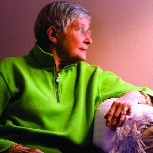Feldenkrais Method May Help People With Alzheimer’s

The Feldenkrais Method may improve quality of life for patients with Alzheimer’s and enable them to learn new habits, according to an article published in Alzheimer’s Care Quarterly (2006; 7 [4], 278–86).
As Alzheimer’s disease progresses, individuals lose reasoning and communication abilities. Motor skills are retained the longest. The more that patients can remain physically active, the better it is for their overall health. The challenge, however, is that as reasoning functions fade, individuals lose awareness of safety issues and have a higher risk of injury.
“Since the Feldenkrais Method changes an individual’s habits, the results of [teaching movement awareness] can produce positive and lasting results through the individual’s
capacity for procedural learning,” says Joyce Ann, a registered and licensed occupational therapist and a guild-certified Feldenkrais practitioner, who teaches Awareness Through Movement® classes at The Wealshire Nursing Facility in Lincolnshire, Illinois. Procedural memory, also referred to as “nondeclarative memory,” is learning by doing and includes repetitive activities, habits and motor learning.
Through her work with numerous Alzheimer’s patients, Ann has found that by improving movement function, she has been able to help individuals breathe better, relax more, have less pain, stop falling, learn to stand independently and even nod in communication. She believes that the Feldenkrais Method offers patients with Alzheimer’s a way to experience gentle, pleasurable movement and to feel warmth and attention. Ultimately, this makes a powerful positive difference in the quality of life for people who have experienced tremendous losses.
To learn more about the Feldenkrais Method, see www.feldenkrais.com.
Shirley Eichenberger-Archer, JD, MA
Shirley Archer, JD, MA, is an internationally acknowledged integrative health and mindfulness specialist, best-selling author of 16 fitness and wellness books translated into multiple languages and sold worldwide, award-winning health journalist, contributing editor to Fitness Journal, media spokesperson, and IDEA's 2008 Fitness Instructor of the Year. She's a 25-year industry veteran and former health and fitness educator at the Stanford Prevention Research Center, who has served on multiple industry committees and co-authored trade books and manuals for ACE, ACSM and YMCA of the USA. She has appeared on TV worldwide and was a featured trainer on America's Next Top Model.






